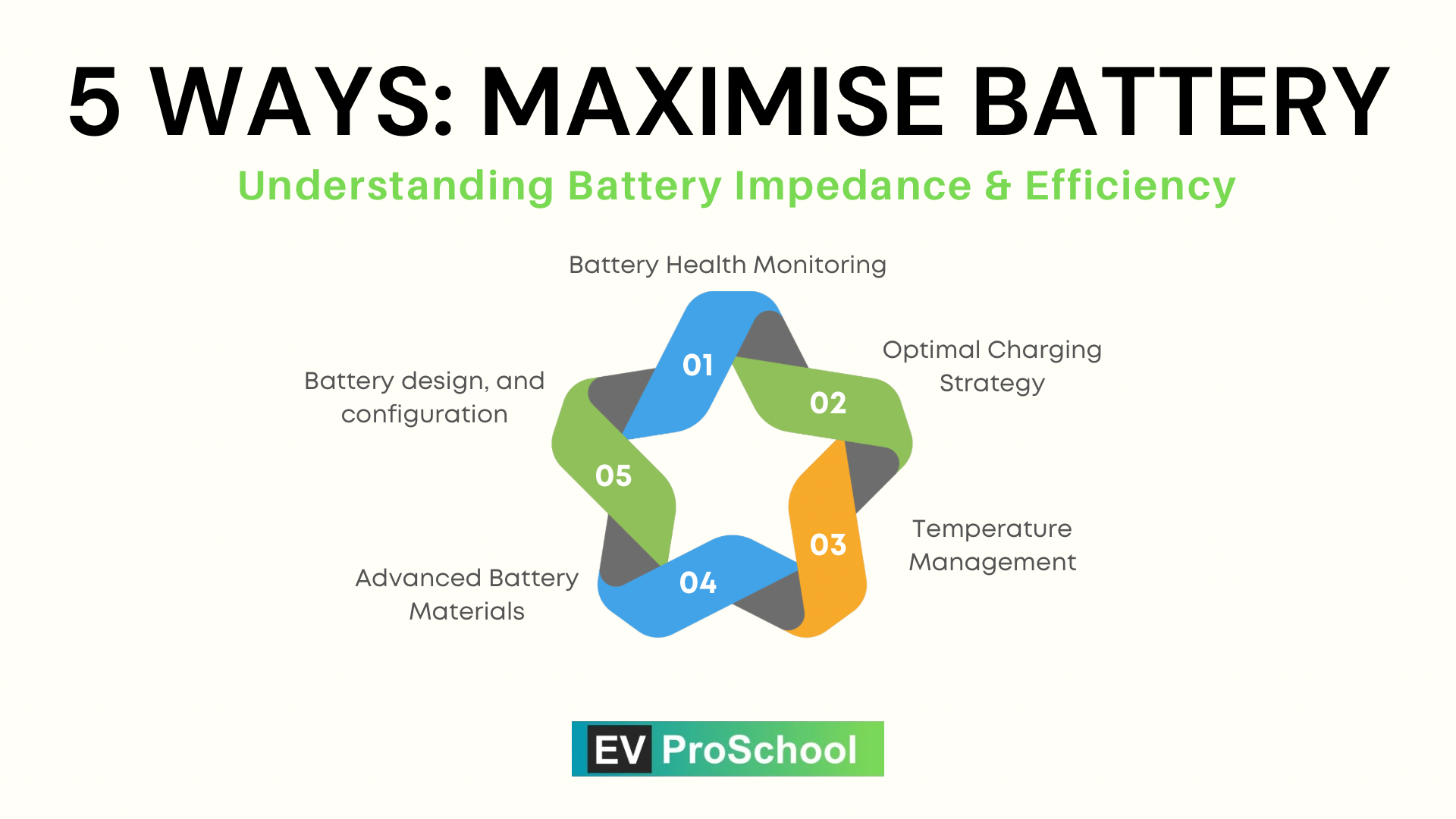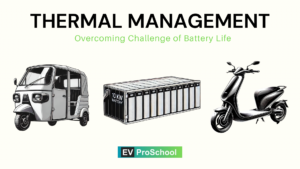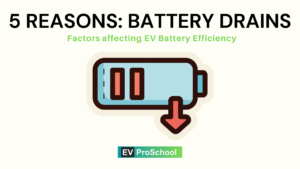In the rapidly evolving landscape of electric vehicles (EVs), understanding and optimizing battery impedance is crucial for enhancing overall vehicle efficiency and performance. Electrochemical Impedance Spectroscopy (EIS) can detect battery degradation up to six months earlier than traditional method.
This article delves into the importance of battery impedance in electric vehicles. Let’s unfold the performance of battery impedance and its seamless connection to the efficiency of EVs.
Introduction to Battery Impedance
Impedance testing of batteries is a useful method to assess the health and condition of batteries by measuring their internal resistance or impedance. This can indicate how well the battery can deliver power under load and its overall state of health. With EV production scaling, ensuring cell quality across batches has become a significant challenge. Variations from 5% up to 20% in impedance are observed, which can compromise safety and performance.
Battery impedance, a measure of opposition to the current flow, plays a pivotal role in determining an EV’s efficiency, battery life, and charge rate. Lower impedance means a battery can deliver more power to the EV’s motor, enhancing performance and extending the range.

Image Source : Linkedin.com
As India’s EVmarket accelerates, battery testing has become essential to ensure safety and reliability. With the rise of lithium ion batteries, robust testing standards are key to meeting growing demand and preventing incidents like battery fires. Discover the importance of voltage, current, capacity, and impedance testing for a secure EV future in India.
1. Battery Health Monitoring
Regular monitoring of battery health can identify impedance increases, signaling when maintenance or intervention is necessary. Techniques such as Electrochemical Impedance Spectroscopy (EIS) are used to measure battery impedance accurately, enabling early detection of potential issues.
Impedance testing of batteries is a useful method to assess the health and condition of batteries by measuring their internal resistance or impedance. This can indicate how well the battery can deliver power under load and its overall state of health.
2. Optimal Charging Strategies
Charging strategies impact battery impedance and overall health. Fast charging can increase impedance over time, whereas slow, controlled charging tends to preserve battery condition. Implementing smart charging algorithms that adjust based on battery condition and temperature can optimize charging, reducing impedance.
Battery life is not just about how many years they’ve been dancing; it’s about the number of dance routines (cycles) they can gracefully complete. The depth of discharge (DOD) measures how much energy dancers use before taking a breather.
3. Temperature Management
Temperature significantly affects battery impedance. Operating an EV within the optimal temperature range can lower impedance, thereby improving efficiency. Advanced cooling and heating systems in EVs help maintain battery temperature, enhancing performance and longevity.
4. Use of Advanced Battery Materials
The choice of battery materials can influence impedance. Materials with higher conductivity and better electrochemical properties can reduce impedance, leading to more efficient batteries. Ongoing research into new materials and battery technologies promises further improvements in EV battery efficiency.
Regulatory Compliance: The new EU Batteries Regulation mandates the use of recycled materials in new batteries to support a circular economy and reduce environmental impact. By 2030, new batteries must contain:
12% recycled cobalt
4% recycled lithium
4% recycled nickel3
Additionally, the regulation sets ambitious recovery rate targets:
70% of lithium-ion battery weight by 2030
95% recovery rate for cobalt, nickel, and copper by 2030

Image Source : Linkedin
While there is a high volume of research on new battery materials, few make it to the commercial market due to several key factors. Many promising materials face challenges in scalability, where lab success doesn’t easily translate to industrial production. Cost is another major barrier, as new materials often need to be economically viable and cost-competitive with existing technologies. Additionally, manufacturing complexities, performance issues in real-world conditions, and regulatory hurdles further limit the transition from research to commercialization. The market’s readiness and risk aversion in adopting unproven technologies also play crucial roles, causing only a select few materials to successfully reach commercial use.
5. Battery Design and Configuration
Battery design and configuration affect impedance levels. Optimizing the internal structure of battery cells and modules can reduce internal resistance, thereby lowering impedance. Engineers are continuously exploring designs that maximize energy density while minimizing impedance.
The evolving quest for optimal battery pack design faces challenges of standardization, material sourcing, and sustainability. While diverse innovations emerge, achieving the ideal balance of energy density, lifespan, and cost-effectiveness remains critical for widespread adoption.
Conclusion: The Future of Battery Impedance
The entire battery lifecycle presents opportunities for innovation, efficiency and circularity.
The most critical component of an EV is the battery. The advancements in battery technology, especially lithium-ion and solid-state batteries, are key to the future of EVs. These innovations directly impact range, charging speed, and overall performance.
Advancements in battery technology and impedance measurement techniques are paving the way for more efficient electric vehicles. As understanding of impedance improves, future EVs will benefit from longer ranges, faster charging, and extended battery lives, contributing significantly to the sustainability and appeal of electric mobility.
Incorporating these strategies to manage battery impedance effectively can lead to significant enhancements in EV efficiency and performance, marking a pivotal step towards a more sustainable and electrified future.
Strategy for the Blog Post: “5 Ways to Maximize EV Battery Efficiency: Understanding Impedance”
This blog post will explore the key methods to improve EV battery efficiency, focusing on understanding impedance (internal resistance) and how factors like charging habits, thermal management, and usage patterns affect performance. The post will provide actionable tips for EV users to extend battery life and optimize efficiency.
1. Define the Blog’s Objectives
Purpose:
- To educate readers on how impedance impacts EV battery performance.
- Provide practical tips to maximize efficiency and extend battery life.
Target Audience:
- EV owners and enthusiasts seeking to optimize their battery’s performance.
- Eco-conscious readers interested in sustainable EV usage.
- Industry professionals or engineers curious about advanced battery management concepts.
SEO Focus Keyword:
“EV battery efficiency”
Supporting Keywords:
- Impedance in EV batteries
- EV battery performance
- Charging habits for EVs
- Thermal management for batteries
- Reducing internal resistance
2. Blog Outline
Title Options:
- Main Title: 5 Ways to Maximize EV Battery Efficiency: Understanding Impedance
- SEO-Friendly Title: How to Boost EV Battery Efficiency: Tips on Charging, Impedance, and More
Introduction: Why Battery Efficiency Matters
- Start with a hook:
“Did you know that a small change in how you charge your EV or manage its temperature can significantly extend your battery’s life and improve its efficiency?” - Explain why maximizing battery efficiency is crucial for:
- Extending EV range.
- Reducing environmental impact.
- Saving money on battery replacements.
- Briefly introduce the role of impedance and how this post will cover five actionable strategies.
Section 1: What Is Impedance in EV Batteries?
- Definition: Explain impedance as the internal resistance that hinders the flow of electricity in a battery.
- Impact on Efficiency:
- High impedance leads to energy loss (as heat) and reduces efficiency.
- Increased impedance over time can lower the battery’s capacity and output power.
- Factors Influencing Impedance:
- Aging of the battery (degradation of materials).
- Temperature extremes (too hot or too cold).
- Visual Idea: Diagram showing how impedance affects energy flow within a battery.
Section 2: 5 Ways to Maximize EV Battery Efficiency
1. Minimize Internal Resistance
- Why It Matters: Internal resistance increases energy loss and heat generation.
- Tips to Reduce Resistance:
- Avoid deep discharges and overcharging (e.g., keep the battery between 20%–80%).
- Regularly use your EV to prevent battery stagnation.
2. Practice Smart Charging Habits
- Why It Matters: Proper charging reduces stress on battery cells.
- Best Practices:
- Use fast charging sparingly; rely on slow, overnight charging when possible.
- Avoid charging the battery to 100% regularly unless necessary for long trips.
- Charge in moderate temperatures to improve charging efficiency.
3. Monitor and Manage Thermal Conditions
- Why It Matters: Extreme temperatures (hot or cold) increase impedance and accelerate degradation.
- Tips for Thermal Management:
- Park your EV in a garage or shaded area during hot weather.
- Precondition your battery in cold weather before charging or driving.
- Use built-in thermal management systems (most EVs have heating or cooling systems for batteries).
4. Optimize Driving and Usage Patterns
- Why It Matters: Aggressive driving and frequent acceleration increase stress on the battery.
- Tips for Efficient Driving:
- Drive at consistent speeds and avoid frequent hard acceleration/braking.
- Use regenerative braking to recover energy.
5. Regularly Update Battery Management Software
- Why It Matters: Modern EVs often receive updates that optimize battery performance and reduce impedance.
- Tips:
- Ensure your EV’s software is up to date to take advantage of performance improvements.
- Follow manufacturer recommendations for battery maintenance.
Section 3: How Impedance and These Strategies Work Together
- Explain how reducing impedance improves the battery’s energy flow and reduces heat loss.
- Tie the strategies together:
- Smart charging reduces stress and impedance buildup.
- Thermal management ensures resistance stays within an optimal range.
- Efficient driving minimizes energy loss, preserving battery capacity.
- Real-World Example:
“Tesla’s software updates often optimize battery charging rates and improve thermal management, directly reducing impedance and extending battery life.”
Section 4: Benefits of Maximizing Battery Efficiency
- Longer Battery Life: Fewer replacements, reducing costs.
- Extended Driving Range: Maximizing the energy available from the battery.
- Reduced Environmental Impact: Lower degradation means fewer resources needed for battery replacements.
- Stat to Include:
- “According to a study by the Department of Energy, maintaining proper battery conditions can extend EV battery life by up to 40%.”
Conclusion: Small Changes, Big Impact
- Summarize the five strategies:
- Reducing internal resistance.
- Practicing smart charging.
- Managing thermal conditions.
- Driving efficiently.
- Keeping software updated.
- Encourage readers to adopt these practices to improve their EV experience.
- End with a call-to-action:
“Want to learn more about maintaining your EV battery? Check out our guide to EV battery health and performance tips!”
3. Writing Style and Tone
- Tone: Informative yet conversational, appealing to both EV owners and technical readers.
- Use analogies to simplify concepts:
- “Think of impedance like a clogged pipe—it makes it harder for electricity to flow efficiently, wasting energy along the way.”
4. Suggested Visuals and Graphics
- Infographic:
- Five strategies to maximize battery efficiency (internal resistance, charging, thermal management, etc.).
- Diagram:
- How impedance affects the flow of energy within a battery.
- Chart:
- Impact of proper charging habits on battery lifespan.
- Real-World Image:
- EVs charging in moderate temperatures with thermal systems highlighted.
5. SEO Optimization Strategy
Focus Keyword:
“EV battery efficiency”
Supporting Keywords:
- Impedance in EV batteries
- Improve battery performance
- Smart charging habits for EVs
- Thermal management systems
- EV battery tips
Meta Description:
“Boost EV battery efficiency with these 5 expert tips! Learn about reducing internal resistance, smart charging habits, thermal management, and more to maximize your EV’s performance and lifespan.”
Alt Text for Feature Image:
“Infographic showing five ways to maximize EV battery efficiency, including impedance reduction, thermal management, and smart charging habits.”
6. Blog Length
- Target Word Count: 1,500–1,800 words to balance technical depth and readability.
By following this strategy, the blog will serve as a practical, engaging, and SEO-friendly guide for EV users, empowering them to get the most out of their batteries while understanding the role of impedance in efficiency.



